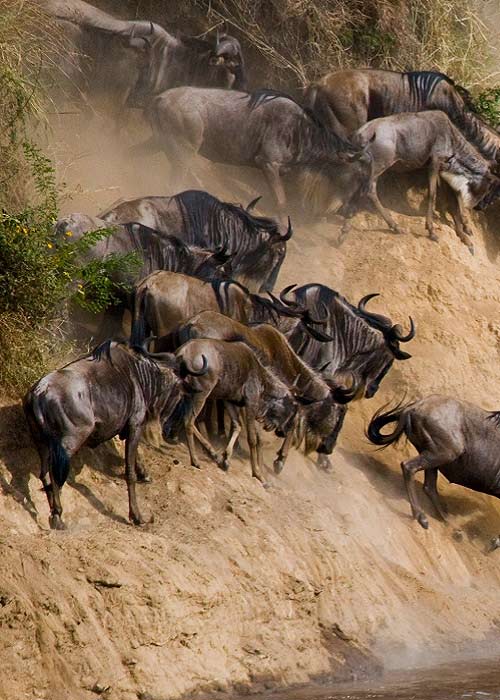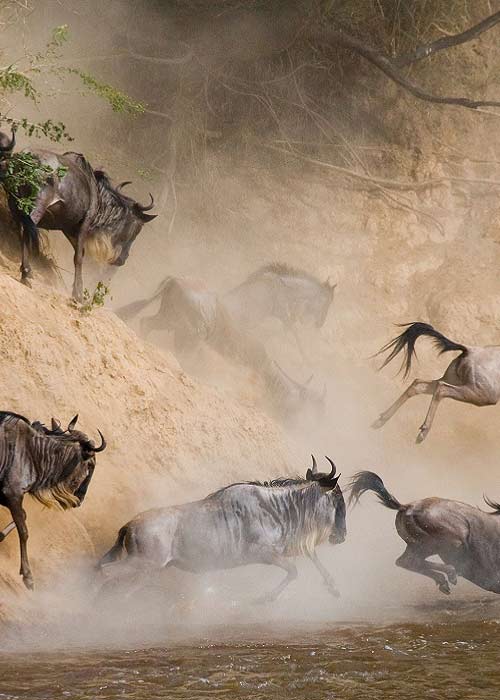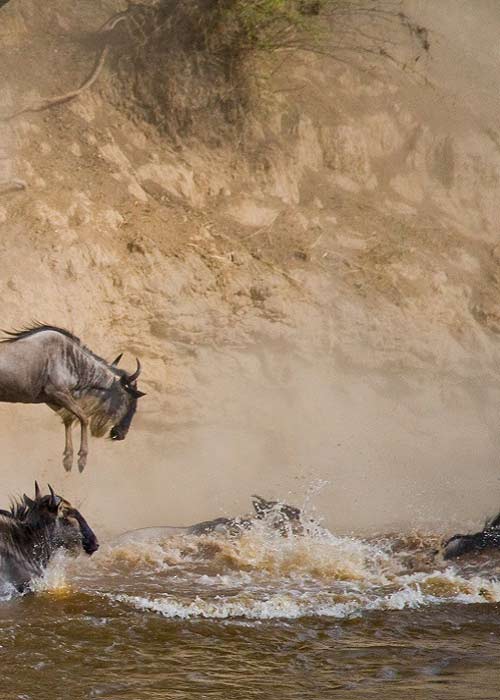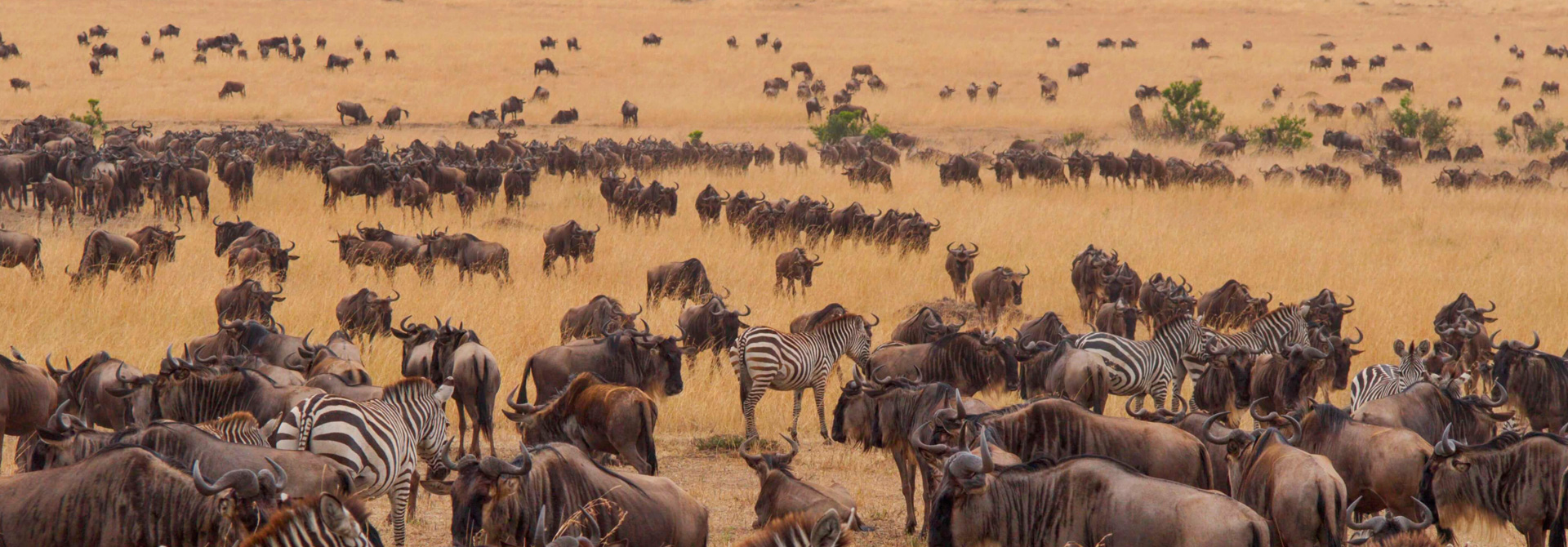Wildebeest Migration
Every year over 1 million wildebeests, zebras and gazelles comes to the Masai Mara. To graze the lush green grasslands and to mate. The fortunate spectator cannot leave the Mara without feeling blessed seeing the magic and wonder of Mother Nature.
The wildebeest migration from the Serengeti to the Masai Mara is believed to be the greatest and most spectacular migration in the world. It all starts in the Masai Mara. Once safely arrived to the Masai Mara National Reserve during the months of June to July the wildebeest moves further to the private conservancy areas such as the Mara North Conservancy to graze the endless and plentiful lush green plains and to mate.



Wildebeests migrate to graze and mate
The wildebeest bulls begin their mating ritual by calling and attracting the wildebeest cows. An estimated 200,000 wildebeest bulls and 600,000 wildebeest cows meet this way. The dominant bulls give out a very distinct calling sound through their nose. A resonance almost like the one of a frog. They fill the plains. Both in numbers and in sound. The wildebeest mating ritual is believed to last few days only; to ensure all calves are born on the very same time for greater protection.
And then. In the mid of October, when most of the grasses on the Mara savannah have been eaten, the wildebeest prepares to move southwards to seek the generous grasslands areas of the Serengeti. To give birth to their calves on the plains of the Ngorongoro Crater in Tanzania. When the area begins to dry out and the grasses and water becomes scarce the wildebeest set to move again. Scientists believe that the old wildebeest can sense water up to a distance of 50km away using lightning and thunder as the guiding light. These patriarchs will urge the herds onwards. In search of water a greener pastures. Returning to the Masai Mara and yet again begin the cycle of life.
The wildebeests contribute to the Masai Mara Ecosystem. It is estimated that they leave behind 60,000 tones of dung fertilizing the Mara grassland.
Crossing the Mara River
Trekking the vast distance from the Serengeti to the Masai Mara and back is a deadly affair. It is estimated that the wildebeests covers a range distance of 3,000km2 on their long migratory cycle every year. With their newborns in tow. Many die before even reaching the Masai Mara.
On the plains the big cat predators are awaiting the great number of prey. Accompanied by the vultures. Flying high above or waiting in the tall acacias with their sharp beaks for the unfortunate to die before feeding on them.
But the most fatal of all dangers are the crossing of the Mara River. The wildebeests are gathering at the bank of the River Mara. In greater and greater numbers. Nervously waiting. Moving back and forth. None wish to be the firsts to descent the steep Mara banks and plunge into its waters. Filled with the huge crocodiles of the old world. All anticipating this twice a year feast.
Suddenly one are almost pushed into the water. Followed by hundreds and hundreds of his companions who jumps down the bank. Swimming desperately to reach the safe banks. Avoiding by all means to get caught in a deadly set of razor sharp jaws.
Lurking crocodiles
Many wildebeest are caught and eaten by the luring crocodiles. But most die because of drowning. Or because they fatally break a leg on their way down the banks. Others die in the rush and excitement. Trampled to death.
The wildebeests have many crossing points at the Mara River. There is one, the Kichwa Tembo Crossing Point, within the Mara North Conservancy. And two crossing points within the Masai Mara National Game Reserve. But sometimes and somehow the wildebeest just pile themselves in such great numbers anywhere at the banks that the first ones literally are being pushed down the steep banks and falls into the river water.
Crossing points
Karen Blixen Camp invites visitors to have a chance to see the wildebeest crossing the Mara River. One of the most spectacular shows on earth. We arrange full day game drives to the different crossing points throughout the migrating season.
There are three favored crossing points in the Masai Mara. Our nearest crossing point is the Kichwa Crossing Point, which is located within the Mara North Conservancy, with only a 25-30 minutes drive away from the camp. The second crossing is the Little Governor’s Crossing Point, which is located within the Masai Mara National Game Reserve and is approximately 45 minutes drive away. The third crossing is the Serena Crossing Point and is also located within the National Game Reserve with a 1,5 hour drive away from Karen Blixen Camp.
Our safari guides will take guests to the particular crossing point where they expect the wildebeests may cross the Mara River.

Start Planning Your Safari
Let us help you plan your trip, efficiently and at the best rates. Get in touch with your inquiries or book instantly if you are a return guest. We look forward to be of assistance.






